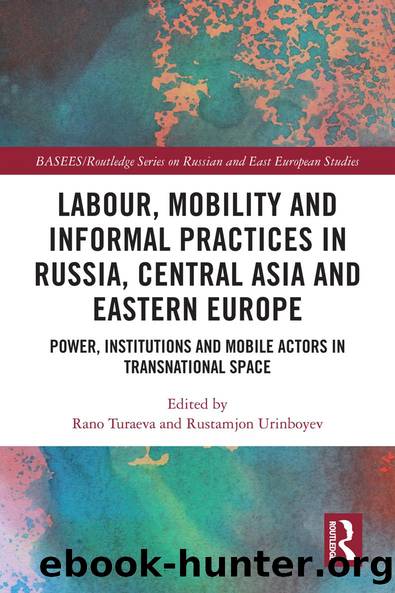Labour, Mobility and Informal Practices in Russia, Central Asia and Eastern Europe by Rano Turaeva Rustamjon Urinboyev

Author:Rano Turaeva, Rustamjon Urinboyev [Rano Turaeva, Rustamjon Urinboyev]
Language: eng
Format: epub
ISBN: 9781032010144
Barnesnoble:
Publisher: Taylor & Francis
Published: 2021-05-27T00:00:00+00:00
Notes
1 Globally in 2019, 52% of international migrants were male; 48% were female (IOM 2019: 22).
2 We strictly adhered to the principles of confidentiality and anonymity in order to protect the identities of the migrants we spoke with during our fieldwork.
3 The empirical data collection was conducted under the research project âMigration, shadow economy and parallel legal orders in Russiaâ, by Anna-Liisa Heusala, Kaarina Aitamurto and Rustamjon Urinboyev in 2017, and Sherzod Eraliev in 2019.
4 BBC Uzbek Service, âA migrant who became a second wife is kicked out with two childrenâ (in Uzbek), 20 December 2019. Accessed 25 May 2020, https://www.bbc.com/uzbek/uzbekistan-50872438.
5 The Russian Ministry of Interior reported that there were 2.1 million people from Uzbekistan, 1.2 million from Tajikistan and 700,000 from Kyrgyzstan in late 2019. Selected indicators of the migration situation in the Russian Federation for JanuaryâDecember 2019 with a distribution by countries and regions (in Russian), 22 January 2020. Accessed 25 May 2020, https://xn--b1aew.xn--p1ai/Deljatelnost/statistics/migracionnaya/item/19365693/ .
6 When one co-author of this chapter visited Moscow in the autumn of 2019, he was approached several times by posredniki (middlemen) or qogâozchilar (literally, papermen in Uzbek) in and around Kazansky railway station, with offers of different types of âcleanâ documents.
7 According to Russian officials, one-third of migrants are employed in retail, 16% in construction, 14% in transportation and communications, 7% in the hotel industry and 8% in domestic services (such as cleaning and caring for the elderly). Sputniknews, Trudovye migranty v samoizolyatsii, 6 April 2020. Accessed 25 May 2020, https://tj.sputniknews.ru/columnists/20200406/1031017523/trudovye-migranty-samoizolyaciya-perevody-koronavirus.html .
8 Fergananews, Podkidyshi i tishina (in Russian, Foundling and silence), 25 February 2020. Accessed 25 May 2020, https://fergana.ru/articles/115439/.
9 BBC Uzbek, âA migrant who became a second wife is kicked out with two children (in Uzbek)â, 20 December 2019. Accessed 25 May 2020, https://www.bbc.com/uzbek/uzbekistan-50872438.
10 A government agency in Uzbekistan inherited from the Soviet period that dealt with womenâs issues until its incorporation into the newly established Ministry of Mahalla and Family Affairs in February 2020.
11 One of the social consequences of this migration is that many male migrants found new families and divorced their wives. One study found that, each year, 14,000 Tajik migrants established new families in Russia and abandoned their wives (Malyuchenko 2015).
12 BBC Uzbek, âA migrant who became a second wife is kicked out with two children (in Uzbek)â, 20 December 2019. Accessed 25 May 2020, https://www.bbc.com/uzbek/uzbekistan-50872438.
13 As Cleuziou and Commercio (2016) note, women agree to a second wife status 1) to acquire economic resources in economically challenging times; 2) to acquire marital status in what remains a traditional society that dismisses an âold maidâ, single or divorced woman and 3) to acquire biological resources, that is, to have children.
Download
This site does not store any files on its server. We only index and link to content provided by other sites. Please contact the content providers to delete copyright contents if any and email us, we'll remove relevant links or contents immediately.
Cecilia; Or, Memoirs of an Heiress — Volume 1 by Fanny Burney(32434)
Cecilia; Or, Memoirs of an Heiress — Volume 2 by Fanny Burney(31869)
Cecilia; Or, Memoirs of an Heiress — Volume 3 by Fanny Burney(31852)
The Great Music City by Andrea Baker(31327)
We're Going to Need More Wine by Gabrielle Union(18967)
All the Missing Girls by Megan Miranda(15564)
Pimp by Iceberg Slim(14382)
Bombshells: Glamour Girls of a Lifetime by Sullivan Steve(13972)
Talking to Strangers by Malcolm Gladwell(13222)
Norse Mythology by Gaiman Neil(13204)
Fifty Shades Freed by E L James(13157)
For the Love of Europe by Rick Steves(12931)
Mindhunter: Inside the FBI's Elite Serial Crime Unit by John E. Douglas & Mark Olshaker(9190)
Crazy Rich Asians by Kevin Kwan(9167)
The Lost Art of Listening by Michael P. Nichols(7403)
Enlightenment Now: The Case for Reason, Science, Humanism, and Progress by Steven Pinker(7228)
The Four Agreements by Don Miguel Ruiz(6625)
Bad Blood by John Carreyrou(6546)
Weapons of Math Destruction by Cathy O'Neil(6142)
